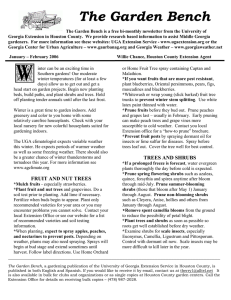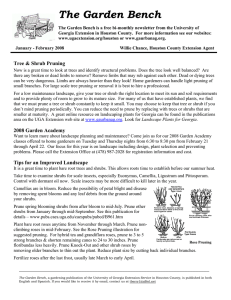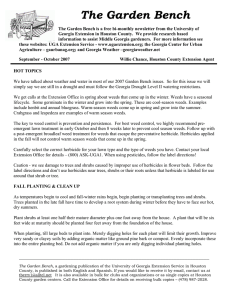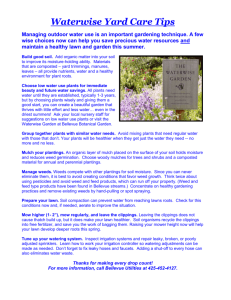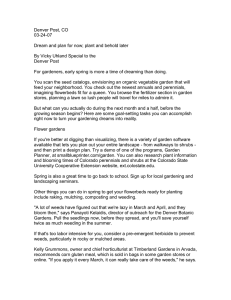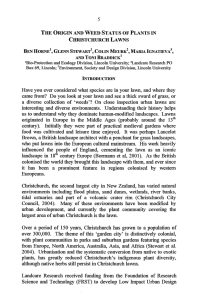The Garden Bench
advertisement
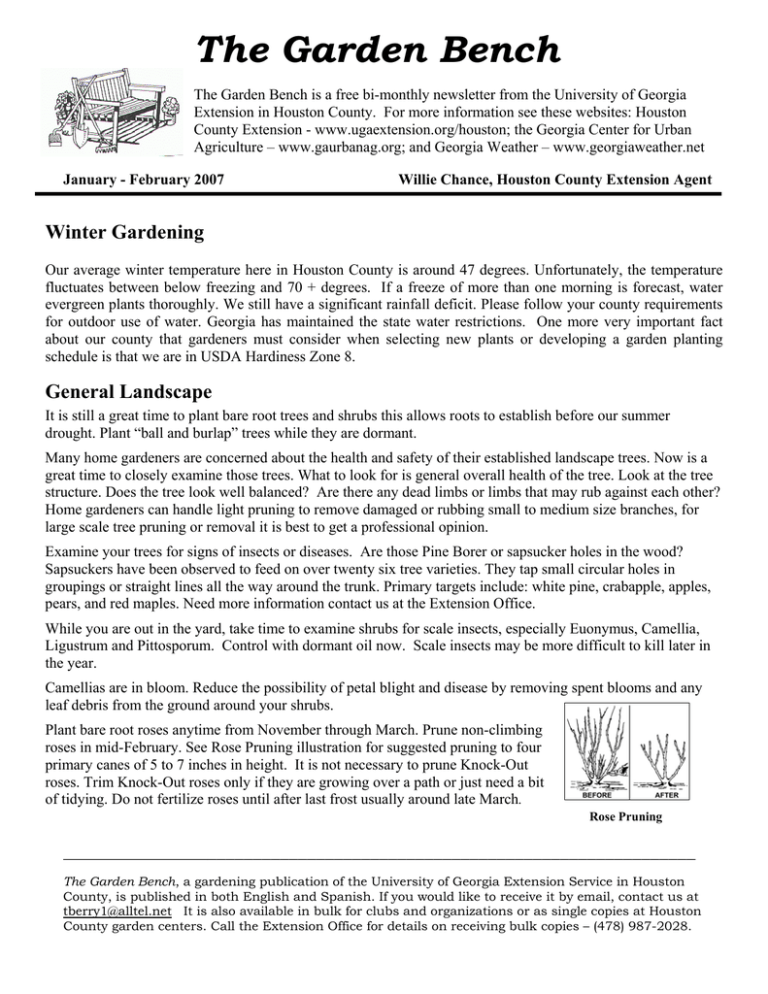
The Garden Bench The Garden Bench is a free bi-monthly newsletter from the University of Georgia Extension in Houston County. For more information see these websites: Houston County Extension - www.ugaextension.org/houston; the Georgia Center for Urban Agriculture – www.gaurbanag.org; and Georgia Weather – www.georgiaweather.net January - February 2007 Willie Chance, Houston County Extension Agent Winter Gardening Our average winter temperature here in Houston County is around 47 degrees. Unfortunately, the temperature fluctuates between below freezing and 70 + degrees. If a freeze of more than one morning is forecast, water evergreen plants thoroughly. We still have a significant rainfall deficit. Please follow your county requirements for outdoor use of water. Georgia has maintained the state water restrictions. One more very important fact about our county that gardeners must consider when selecting new plants or developing a garden planting schedule is that we are in USDA Hardiness Zone 8. General Landscape It is still a great time to plant bare root trees and shrubs this allows roots to establish before our summer drought. Plant “ball and burlap” trees while they are dormant. Many home gardeners are concerned about the health and safety of their established landscape trees. Now is a great time to closely examine those trees. What to look for is general overall health of the tree. Look at the tree structure. Does the tree look well balanced? Are there any dead limbs or limbs that may rub against each other? Home gardeners can handle light pruning to remove damaged or rubbing small to medium size branches, for large scale tree pruning or removal it is best to get a professional opinion. Examine your trees for signs of insects or diseases. Are those Pine Borer or sapsucker holes in the wood? Sapsuckers have been observed to feed on over twenty six tree varieties. They tap small circular holes in groupings or straight lines all the way around the trunk. Primary targets include: white pine, crabapple, apples, pears, and red maples. Need more information contact us at the Extension Office. While you are out in the yard, take time to examine shrubs for scale insects, especially Euonymus, Camellia, Ligustrum and Pittosporum. Control with dormant oil now. Scale insects may be more difficult to kill later in the year. Camellias are in bloom. Reduce the possibility of petal blight and disease by removing spent blooms and any leaf debris from the ground around your shrubs. Plant bare root roses anytime from November through March. Prune non-climbing roses in mid-February. See Rose Pruning illustration for suggested pruning to four primary canes of 5 to 7 inches in height. It is not necessary to prune Knock-Out roses. Trim Knock-Out roses only if they are growing over a path or just need a bit of tidying. Do not fertilize roses until after last frost usually around late March. Rose Pruning ______________________________________________________________________ The Garden Bench, a gardening publication of the University of Georgia Extension Service in Houston County, is published in both English and Spanish. If you would like to receive it by email, contact us at tberry1@alltel.net It is also available in bulk for clubs and organizations or as single copies at Houston County garden centers. Call the Extension Office for details on receiving bulk copies – (478) 987-2028. Lawns For a beautiful green lawn in Spring take a few precautionary steps in January and February. The weeds in lawns now are leftover winter weeds. Winter weed control is difficult once weeds get fairly large. You can spray broadleaf weeds with Weed-B-Gon 33-Plus, or equivalent. Expect poor control when using herbicides now. You may want to just mow the weeds before seeds form. To control wild onion and wild garlic present in your lawn use two sprays of Image four weeks apart. To prevent summer weeds apply a pre-emergence weed killer in late February and again 45 days later to prevent summer weeds. Do not use it if you plan to seed your lawn within 45 to 60 days. You can use Atrazine for all lawns except Bermuda grass. Halts pendamethalin), Balan (benefin), Surflan (oryzalin) and XL can be used on all warm season lawn grasses. Contact the Extension Office or see the label to see which weeds each one controls. January is a perfect time to do a soil test as soon as possible and add lime if needed. Do not lime lawns unless asked to by a soil sample. You can raise the pH too high and damage lawns – especially centipede lawns. Improve air flow, water absorption and the effectiveness of fertilizers and weed killers by removing lawn thatch layer thicker than one-half inch (one inch for St. Augustine lawns). De-thatch the lawn in January or February. Do not de-thatch lawns once they begin to green up. Flowers Our crazy weather is causing early bulb development. We are beginning to see green shoots and leaves on many of the spring blooming bulbs. There is nothing we can do about this but enjoy the hint of Spring. Fertilize bulbs when the plant gets two to three inches tall. Apply one pound of 10-10-10 per 100 square feet, or another equivalent fertilizer. Keep the soil moist but not overly wet. After the bloom dies, do not cut off the foliage until it turns brown. These leaves replenish the bulb’s food supply for next year’s bloom. To increase bloom and color, continue deadheading and fertilizing Pansies. Fertilize Pansies monthly with granular fertilizer or bi-weekly with liquid fertilizer. Prepare your beds for annual flowers. Do a soil test and add lime and fertilizer as needed. Plant hardy annuals and biennials such as Baby’s Breath, Sweet Peas, Foxglove, Ornamental Cabbage, Kale, Sweet William, and Calendulas. Vegetables / Herbs Plan your vegetable garden now. Pick an area near the house, if possible. You will need 8 to 10 hours of sunlight and a good water supply. Select vegetables that your family likes. Choose vegetables that grow well in your area. Maximize garden space by developing a plant plot or map for each vegetable you choose. Consider the mature height of crops like corn and poled beans. Ensure that there is good air flow and adequate sun light for each plant in the garden during the growing season. Prepare garden for planting. For winter and early spring plantings, use raised beds for better drainage and earlier soil warm-up. Put plenty of mulch between the rows to control weeds. Plant English peas, onion sets or plants. Start seeds of hardy vegetables like cabbage, collards, broccoli, onion, lettuce and cauliflower indoors. Give seedlings plenty of light. Place them in a south-facing window, a cold frame or hothouse, or within 12 to 18 inches of a fluorescent light. The University of Georgia and Fort Valley State University, the U.S. Department of Agriculture and the counties of the state cooperating. The Cooperative Extension Service offers educational programs, assistance and materials to all people without regard to race, color, national origin, age, sex or disability. An equal opportunity/affirmative action organization committed to a diverse work force.
